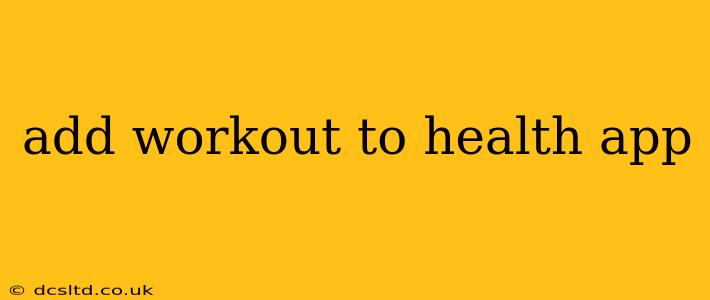Adding Workouts to Your Health App: A Comprehensive Guide
Tracking your fitness journey is easier than ever thanks to health apps. But knowing how to effectively add your workouts to these apps is crucial for maximizing their benefits. This guide covers various methods and considerations, ensuring you get the most accurate and insightful data from your health tracking.
What Health Apps Are Available?
Many health apps are available, each with its strengths and weaknesses. Some popular options include Apple Health, Google Fit, Samsung Health, Fitbit, and MyFitnessPal. The process of adding workouts varies slightly depending on the app you're using, but the underlying principles remain the same. Consider factors like integration with wearable devices, social features, and the specific data you want to track when choosing your app. Some apps excel at detailed workout tracking, while others focus on broader health metrics.
How to Add Workouts Manually: A Step-by-Step Guide
Most health apps allow manual entry of workouts if your device doesn't automatically track them. Here's a general process:
- Open your health app: Locate the app icon on your phone and tap it to open.
- Find the workout log: This is usually found under a section labelled "Workout," "Exercise," "Activity," or something similar. The exact location varies by app.
- Select the workout type: Choose the activity you performed (e.g., running, cycling, swimming, weightlifting). Many apps offer extensive workout categories and allow for customization.
- Enter workout details: This usually includes the duration, distance (if applicable), calories burned, and average heart rate (if available). Be as accurate as possible for optimal data.
- Save your workout: Once you've entered all the necessary information, save the workout entry. The app will then typically incorporate this data into your overall fitness summary.
How to Automatically Track Workouts with Wearable Devices
Many fitness trackers and smartwatches seamlessly integrate with health apps. This eliminates manual entry and provides more accurate data capture. To enable this:
- Check for app compatibility: Ensure your wearable device and health app are compatible. Most popular brands offer seamless integration.
- Connect your devices: Follow the instructions provided by your app and device to establish a connection. This usually involves authorizing access permissions.
- Start your workout: Begin your workout as usual, wearing your fitness tracker. The tracker will record the relevant data (steps, heart rate, distance, etc.).
- Automatic synchronization: Once your workout is complete, the data will usually synchronize automatically with your health app. Check the app to confirm the data has been correctly uploaded.
What Information Should I Track During My Workouts?
The level of detail you track depends on your fitness goals. However, key metrics include:
- Workout type: (e.g., running, cycling, strength training)
- Duration: How long did the workout last?
- Distance: (Applicable to activities like running, cycling, swimming)
- Calories burned: An estimate based on your activity level, weight, and duration.
- Heart rate: Provides valuable insight into your intensity level.
- Average pace/speed: Helpful for tracking progress over time.
- Sets and reps: (For strength training) Essential for tracking your workout volume.
Troubleshooting Issues with Workout Data
If you experience issues adding workouts or syncing data, here are some troubleshooting steps:
- Check your internet connection: A stable connection is crucial for data synchronization.
- Restart your devices: Restarting your phone and wearable device can often resolve minor glitches.
- Update your apps: Ensure your health app and wearable device firmware are up-to-date.
- Re-pair your devices: If synchronization continues to fail, try re-pairing your wearable device with your health app.
- Contact app support: If problems persist, contact the app's customer support for assistance.
By understanding these methods and troubleshooting tips, you can effectively add your workouts to your chosen health app, gain valuable insights into your fitness progress, and ultimately achieve your health and fitness goals. Remember to choose an app that aligns with your needs and preferences and maintain consistency in your tracking for the best results.
